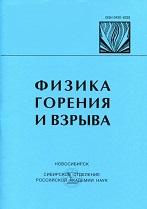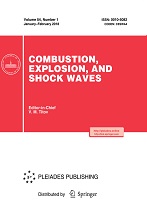|
This article is cited in 6 scientific papers (total in 6 papers)
Combustion of spherical titanium aglomerates in air. III. Movement of agglomerates and the effect of airflow velocity on nanosized combustion products and burning time
O. G. Glotov, G. S. Surodin, A. M. Baklanov
Voevodsky Institute of Chemical Kinetics and Combustion, Siberian Branch, Russian Academy of Sciences, Novosibirsk, 630090, Russia
Abstract:
The combustion of monodisperse titanium particles with a characteristic size of 38 and 320 $\mu$m moving in air has been studied. Pyrotechnic samples generating monodisperse particles were burned in a chamber with a nozzle to impart initial velocity to burning particles. Particles were accelerated by the combustion gas flow from the nozzle. The maximum path-averaged particle velocity relative to the ambient air reached 7.9 m/s. Combustion of moving particles was carried out in a quartz tube 2 m long. At the end of the combustion, combustion products – oxide aerosol – were sampled from the tube using a thermophoretic precipitator. The size distribution function of nanometer-sized spherule particles was determined by processing electron micrographs of samples. The velocity and burning time of the burning particles were determined by video recording at a velocity of 300 frame/s. It was found that increasing the speed of motion of agglomerate particles with a diameter of 320 $\mu$m relative to the gas from 0.9 to 7.9 m/s leads to a decrease in the size of the spherules from 28 to 19 nm and to a decrease in the burning time from 0.45 to 0.26 s.
Keywords:
titanium particle, titanium agglomerate, combustion, particle velocity, characteristic time of fragmentation, burning time, condensed combustion products, nanosized oxide spherule particles, size distribution.
Received: 02.11.2017
Citation:
O. G. Glotov, G. S. Surodin, A. M. Baklanov, “Combustion of spherical titanium aglomerates in air. III. Movement of agglomerates and the effect of airflow velocity on nanosized combustion products and burning time”, Fizika Goreniya i Vzryva, 55:1 (2019), 49–62; Combustion, Explosion and Shock Waves, 55:1 (2019), 43–55
Linking options:
https://www.mathnet.ru/eng/fgv555 https://www.mathnet.ru/eng/fgv/v55/i1/p49
|


|





 Contact us:
Contact us: Terms of Use
Terms of Use
 Registration to the website
Registration to the website Logotypes
Logotypes








 Citation in format
Citation in format 
